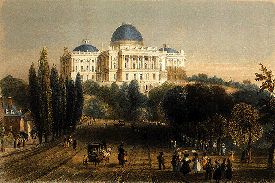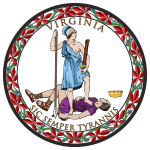
The 17th United States Congress was a meeting of the legislative branch of the United States federal government, consisting of the United States Senate and the United States House of Representatives. While its term was officially March 4, 1821, to March 4, 1823, during the fifth and sixth years of James Monroe's presidency, its first session began on December 3, 1821, ending on May 8, 1822, and its second session began on December 2, 1822, to March 3, 1823. The apportionment of seats in the House of Representatives was based on the 1810 United States census. Both chambers had a Democratic-Republican majority.

The 18th United States Congress was a meeting of the legislative branch of the United States federal government, consisting of the United States Senate and the United States House of Representatives. It met in Washington, D.C., from March 4, 1823, to March 4, 1825, during the seventh and eighth years of James Monroe's presidency. The apportionment of seats in the House of Representatives was based on the 1820 United States census. Both chambers had a Democratic-Republican majority.

The 1822–23 United States House of Representatives elections were held on various dates in various states between July 1, 1822, and August 14, 1823. Each state set its own date for its elections to the House of Representatives before the first session of the 18th United States Congress convened on December 1, 1823. They occurred during President James Monroe's second term.
The 1820–21 United States House of Representatives elections were held on various dates in various states between July 3, 1820, and August 10, 1821. Each state set its own date for its elections to the House of Representatives before the first session of the 17th United States Congress convened on December 3, 1821. They coincided with President James Monroe winning reelection unopposed.
Francis White was a distinguished early American lawyer and politician in what was then the U.S. state of Virginia.

The 1822 United States House of Representatives elections in New York were held from November 4 to 6, 1822, to elect 34 U.S. Representatives to represent the State of New York in the United States House of Representatives of the 18th United States Congress.

Pennsylvania gained three seats in reapportionment following the 1820 United States census. Pennsylvania elected its members October 8, 1822.

The 1822–23 United States Senate elections were held on various dates in various states. As these U.S. Senate elections were before the ratification of the Seventeenth Amendment in 1913, senators were chosen by state legislatures. Senators were elected over a wide range of time throughout 1822 and 1823, and a seat may have been filled months late or remained vacant due to legislative deadlock. In these elections, terms were up for the senators in Class 2.

Although Maine neither gained nor lost seats after the 1820 United States census, redistricting placed two incumbents into the 3rd district. Maine elected its members on April 7, 1823, after the term began but before the new Congress convened. Maine law required a majority for election, with additional ballots taken if a majority were not achieved. This proved necessary in 1823 in the 1st, 3rd, 4th, and 6th districts, but all members were still chosen before the new Congress convened.

New Hampshire elected its members August 26, 1822. New Hampshire law required a candidate to receive votes from a majority of voters for election, that is 1/12 of votes. Only five candidates received the requisite majority, and so a May 11, 1823 run-off election was held for the sixth seat.

Vermont lost one seat in reapportionment following the 1820 United States census. For the 1822 election, Vermont switched back to using a single at-large district. This would be the last year that Vermont would use an at-large district until 1932, when its representation was reduced to a single seat. Vermont elected its members September 3, 1822.

Delaware was reduced once more from two back to one seat after the fourth census, which number has remained constant to the present day. At the time of the 1822 election, the second seat in Delaware's at-large district was vacant, so there was only one incumbent going into the election.

A special election was held in Delaware's at-large congressional district on October 1, 1822 to fill a vacancy left by the resignation of Caesar A. Rodney (DR) on January 24, 1822, having been elected to the Senate. This election was held on the same day as the general elections for Congress in Delaware.

The 1822 special election for Maine's 2nd congressional district was to select the successor for Representative Ezekiel Whitman (F), who resigned from his position on June 1, 1822. Mark Harris won the election, and took his seat on December 2, 1822.

On May 8, 1822, William Lowndes (DR) of South Carolina's 2nd district resigned. A special election was held to fill the resulting vacancy.

On May 8, 1822, the last day of the First Session of the 17th Congress, William Milnor (F) of Pennsylvania's 1st district resigned. A special election was held to fill the resulting vacancy on October 1, 1822, a week before the general elections for the 18th Congress.

On May 8, 1822, the last day of the First Session of the 17th Congress, Henry Baldwin (DR) of Pennsylvania's 14th district resigned from Congress. A special election was held on October 1, 1822, to fill the resulting vacancy.

On May 20, 1822, Samuel Moore (DR) of Pennsylvania's 6th district resigned. A special election was held on October 1, 1822, to fill the resulting vacancy.

On October 17, 1822, Ludwig Worman (F) of Pennsylvania's 7th district died in office. A special election was held to fill the resulting vacancy on December 10, 1822
Indiana gained two seats in reapportionment following the 1820 United States census, and elected its members August 5, 1822.










